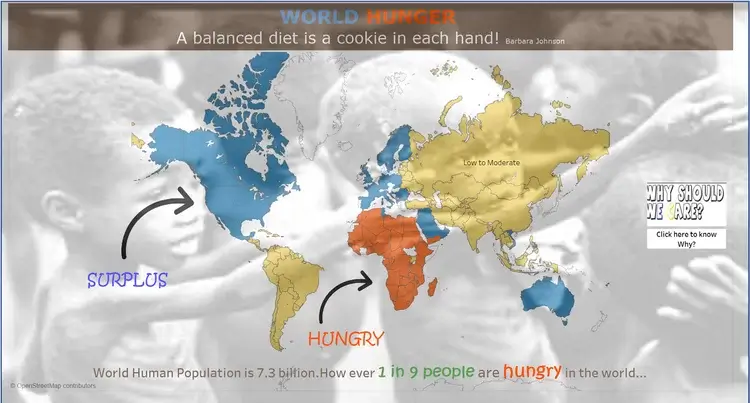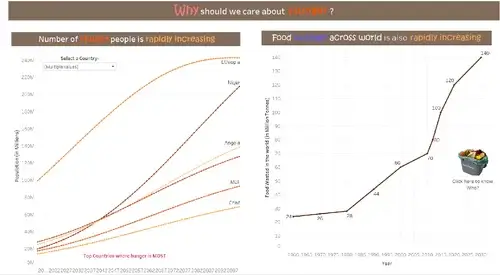Raising Awareness: Addressing the Critical Issue of World Hunger
Join the Discussion: Solutions for a Hunger-Free World
The other day at breakfast, I was reading a newspaper and the headline read –‘About 21,000 people die every day of hunger or hunger-related causes’, according to the United Nations”. It got me thinking as to what is exactly happening in the World?

I immediately felt thankful to have food on my plate every day. To all of us where there is an abundance of food, water, resources and all the luxuries of life – We are not even aware that there is death in the world because of hunger.
Food, Shelter, and Clothing are the basic necessities of life. In one part of the world, 1 billion people are trying to lose weight and in the other part, 1 billion people are dying of hunger! Such a stark contrast. This led me to find out the causes for World Hunger and how can we help reduce it if not “Eliminate” by incorporating a few simple changes in our day to day activities.
Understanding the Scope and Impact of World Hunger
Root Causes of World Hunger: An In-depth Analysis
Global Efforts and Initiatives to Combat Hunger
Individual and Collective Actions for a Hunger-Free Future

I come from a development background and an analytical mindset to solve problems. So, I thought it would be a great idea to combine my experience and passion together to help reduce hunger in the world.
One of the first steps in this process is to collect the data. I started my hunt for data to understand:
• Where is Hunger?
• Why should I worry about hunger?
• Are we producing enough food to feed the entire human population?
• What are the causes of hunger if we are producing enough?
• Who is responsible for the cause?
• How can we reduce hunger and help make this World a better place for ALL OF US?
The Human Toll: Stories from Communities Affected by Hunger
Policy Perspectives: Addressing Systemic Causes of World Hunger
Supporting Nonprofit Organizations: Making a Difference
Creating Sustainable Solutions for Long-Term Hunger Alleviation
Where is Hunger?
It is alarming to know that Africa is the continent where there are a maximum number of hungry people and here is where people die of hunger. Few of the countries in Africa where the Global Hunger Index is very high includes Chad, Ethiopia, Niger, Madagascar, and Angola.
The other continents where there is serious to moderate amount of hunger includes South America and parts of Asia. Now we know where is hunger let us understand if we are producing enough food to feed all the people in the world.
Why should I worry about hunger?

The number of hungry people in the world is increasing and so is the exponential wastage of food. With this trend of food wastage and population increase, we will not be able to feed the entire human population even if we increase our production. Are we producing enough food to feed the entire human population?
For the past two decades, we are producing more food than the rate of population growth in the world. Currently, the population is 7.3 billion. The amount of food produced in the world is 1.5 times more than what is necessary to feed the people present now. So, we are already producing enough food to feed 10 billion people, which is going to be the world population by the year 2050. Thus hunger is not due to food scarcity but due to a variety of other causes like wastage, poverty, and inequality. If we are producing enough, what is there hunger still? We know there is enough production of food, so the prime cause of hunger is Food Wastage.
We just throw away food when we are full and do not feel like eating without even being aware of the fact that there are people dying due to hunger. Our routine practices of throwing leftovers to garbage make it very tough to comprehend the magnitude of food wastage around the globe. The problem is bigger than we think.
Who is responsible for the cause?
The continent of North America especially the United States of America tops the chart in food wastage. Thus, wastage is maximum in those countries where the food is abundant and supposedly called “Industrialized countries” with a very “high literacy” rate.
To just get an intuitive way of understanding the amount of food wasted in the US alone – let us consider this example: Weight of the Empire State Building in Manhattan, NY is 365-kilo tons. Food wasted annually in the US is 60 million tons. Therefore, the annual food wastage in the US is equal to 165 times the weight of Empire State Building.

These are the top 6 states in the US for Grocery and Restaurant Meal Wastage – New Mexico, Nebraska, Mississippi, Ohio, Maryland, Connecticut. At Restaurant level, 45% of the wastage happens at food preparation, 34% at Customer Plates, 21% due to spoilage.
Which food gets wasted the most?
The top category in the US being dairy products followed by fresh vegetables and salad, Cereals, Fruits, Added Sugars, Meat, Added Fats, Eggs, and Bakery. In this order, we see that no one wastes any Bakery stuff. If it’s a pastry or a muffin it will never get wasted! We are wasting healthy food the most and eating as much junk as possible! Evidently, these are the same food categories that are wasted in each household as well. Among the fresh vegetables wasted lettuce leads followed by Potato, Tomato, Broccoli and others. The amount of Lettuce wasted is 270 million dollars.
How can we reduce hunger and help make this World a better place for ALL OF US?
Here are a few simple 1tips to help reduce wastage and thus see to it that everyone has dinner on their plate:
- Shop Wisely: Plan Meals, Use Shopping Lists, Avoid Super Deals and Impulse Buys.
- Learn When Food Goes Bad: People get confused by “Use-by” and “Best-Buy” dates – which are based on manufacturer suggestions for peak quality and can cause people to throw out food for fear that it is spoiled when in fact, it is still consumable.
- Use Your Freezer: Freeze fresh produce and leftovers if you won’t have the chance to eat them before they go bad.
- Request Smaller Portions: Restaurants will open provide half-portions at a reduced cost.
- Eat Leftovers: If you eat out, get your leftovers packaged up
- Compost Food Scraps: Composting food scraps can reduce their climate impact while also recycling their nutrients.
- Donate Food: Non-perishable and unspoiled perishable food can be donated to local banks and shelters.
- Be Aware: Simply being aware of the issue of food waste can help make people more attentive to wasting less.
CHECK OUT MY TABLEAU DASHBOARD TO GET A DETAILED VIEW OF THIS STORY.











 Media Coverage
Media Coverage Press Release
Press Release
